Professor Mike Leach Grades His Washington State Students' Play Design Skills

Toward the end of last year, Washington State football coach Mike Leach asked the university if he could teach a class with his friend, the former state Sen. Michael Baumgartner. They figured there was enough crossover between their respective fields that it could work. Baumgartner had worked in the United States Embassy in Baghdad during the Iraq War; Leach had an affinity for pirates, Geronimo and mesh routes. They’d call the course “Leadership Lessons in Insurgent Warfare and Football Strategies.” Leach sent out a tweet gauging students’ interest, and more than 44,000 people ended up liking it.
This spring, the university green lit the class, and Leach and Baumgartner asked interested students to submit an application, consisting of two essay questions:
1. Can the British strategy for the Malaya Insurgency be used today?
2. Is the Wishbone a viable offense for the NFL? Why or why not?
It seemed like a lot of work, considering this was an ungraded, un-credited seminar. The class would meet once a week, on Wednesday nights, for five weeks, and the sessions would last about 90 minutes each. (For what it’s worth, the fifth class would be a summation of the first four classes, open to the public and live-streamed online.) The students were essentially giving up one of their weeknights and adding an extra class to their courseload in exchange for … what exactly? A private audience with one of the brightest minds in college football, perhaps. Ultimately, 40 students were admitted to the class.
Throughout the semester, Leach gave them a crash course on his famous Air Raid offense. He explained how, at its most basic level, the Air Raid is predicated on creating space and then devising ways to attack that space. Using game tape as a visual aid, he showed the students how he layered routes, moved players before the snap and tried putting the defense in compromising positions in order to achieve those ends. At the very least, the students left with a better understanding of what’s happening when they watch the Cougars play.
As part of the students’ final project, Leach asked them to design three plays, under the premise that he might use one of them in Washington State’s game next season against Houston. “They were really quite impressive plays,” Leach says. “[There was] some dimension to them.” He also thought, intentionally or not, the students combined both aspects of the class in designing their plays. “There was an inclination toward trick plays,” Leach says. “We spent a good amount of time talking about insurgency and counterinsurgency, and probably the most memorable stories [Baumgartner told] were those that offered some level of deception, so the plays also have a little bit of sleight-of-hand and deception involved.”
SI reviewed the students’ plays, picked out our five favorites, and had Leach analyze them. Here are the five plays, in no particular order:
1. Hesitation into “Pick & Roll”
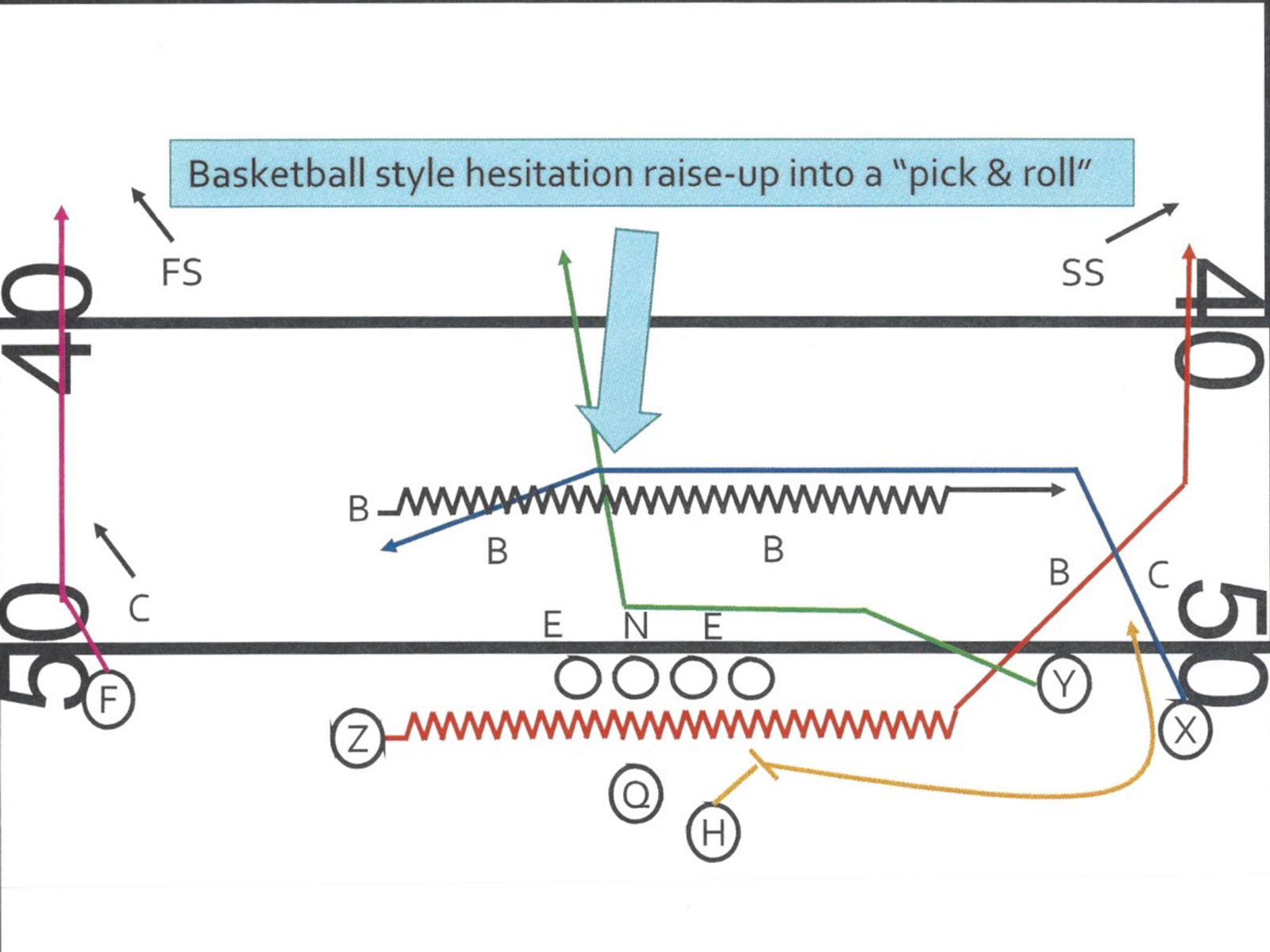
Description: This play involves a good deal of showmanship. As the play develops, the X and Y receivers wave frantically at the quarterback, acting as though they desperately need the ball. Then suddenly, they both stop and relax at the same time, in an effort to trick the defensive backfield into thinking that the play is over for some reason.
Once the defense lets up, the two receivers sprint off of each other, shoulder-to-shoulder, as a guard and a forward often do during a basketball pick-and-roll.
Leach’s take: Of the five plays SI chose, this was the one Leach did not understand right away. He takes another moment to re-read the student’s description. “It’s really a delayed double-move play,” Leach says. “Same effect, kind of.” The difference here is that, before the receivers take off on the second move, they essentially play dead, hoping to lull the defense into a sense of complacency. Then the Y receiver is supposed to break upfield, using the X receiver as the pick man. “It could open up for a big play [for the Y receiver],” Leach says. “I think it’s sort of feast or famine. If you get them, you’re probably going to get all of it.”
Leach is worried, though, that the play could take long to develop. If the defense blitzes and the corners don’t bite on the fake, the quarterback could be in trouble. But the student appears to have considered that, because, as Leach notes, the running back is there in the flat as a safety valve. “I actually think this could work,” Leach says. “I don’t think it’s an ‘every snap’ play. It’s a ‘sometimes’ play. It’s definitely something to think about, for sure.”
2. Huh? Alright, Well, See Ya Later! (Jim Carrey, Dumber and Dumber (sic) (1994))
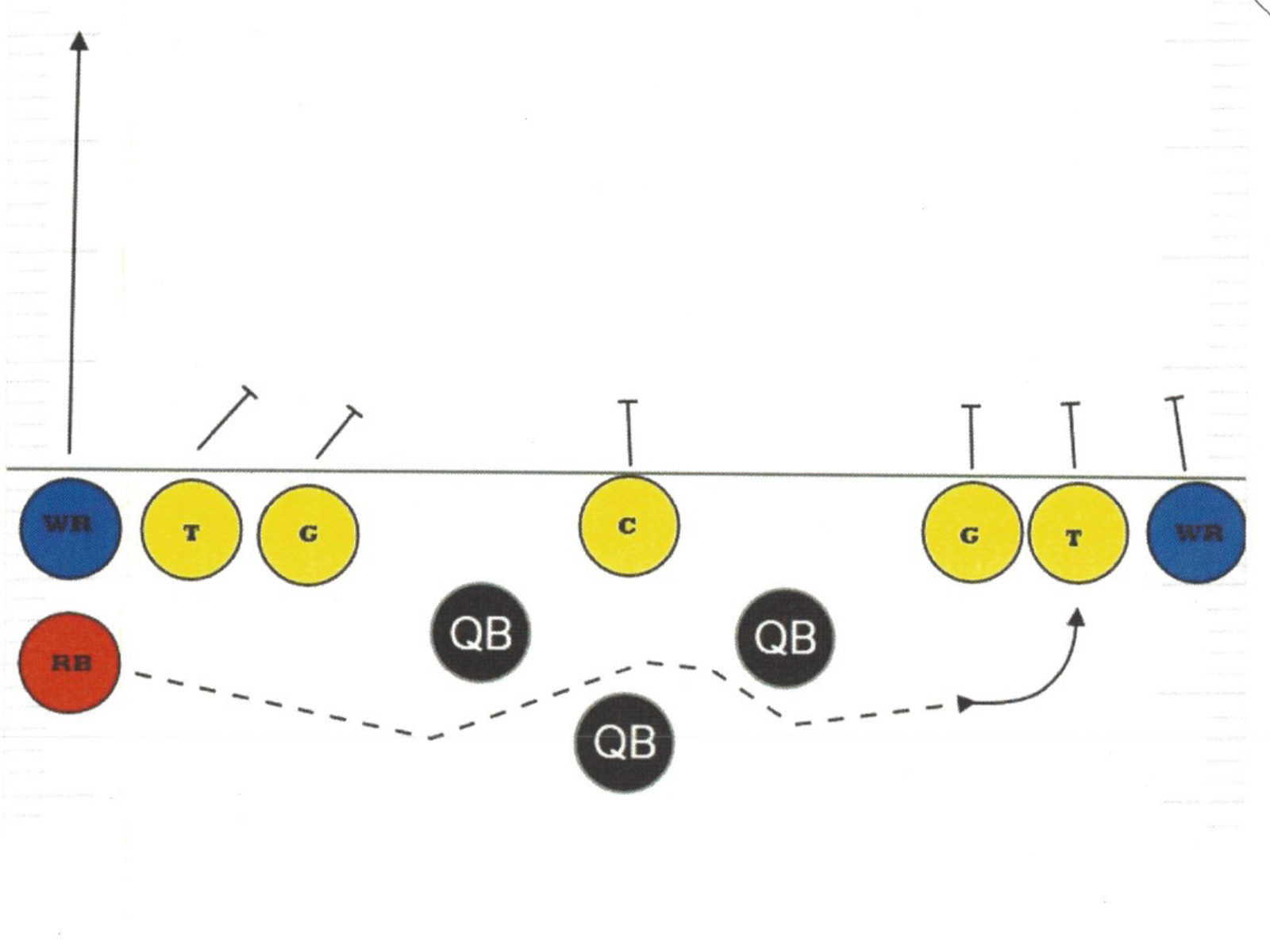
Description: This play takes the classic Emory and Henry formation and adds multiple wrinkles to it. In this version, on both ends of the line of scrimmage, tackles and the guards are lined up outside, next to a wide receiver. The center is all alone, and behind him are three quarterbacks. Together, the center and the quarterbacks form a diamond shape. The center apparently has the option to snap to any of the three quarterbacks, who can run, throw a screen route out wide, or potentially throw the ball downfield. The possibilities seem endless.
Leach’s take: Leach’s first impression is, whatever you run here, the quarterback needs to get rid of the ball fast, because he doesn’t have any protection beyond the center. Leach also thinks you could throw a “pretty good screen” out of this formation, with the guard and tackle lined up out wide to each side. “But you’re kind of stuck with screens,” he says. “It’s hard to get very far downfield, because they’re going to be coming in, trying to pound you.”
If Leach were re-imagining this play, he might not put three quarterbacks in the backfield. He suggests maybe swapping two of the quarterbacks with running backs or receivers, personnel that may be more dynamic with the ball and also more willing to block, to buy the quarterback more time. If Leach were to have three quarterbacks on the field, he says he’d try to run a double-pass, to justify having all of them out there. “As long as you have three quarterbacks in there, you can motion one of the quarterbacks behind one of the piles of the linemen and throw it to him, and he can throw it somewhere, too,” Leach says.
3. Unnamed play (Leach: “This is the guy who really knows how to use a ruler.”)
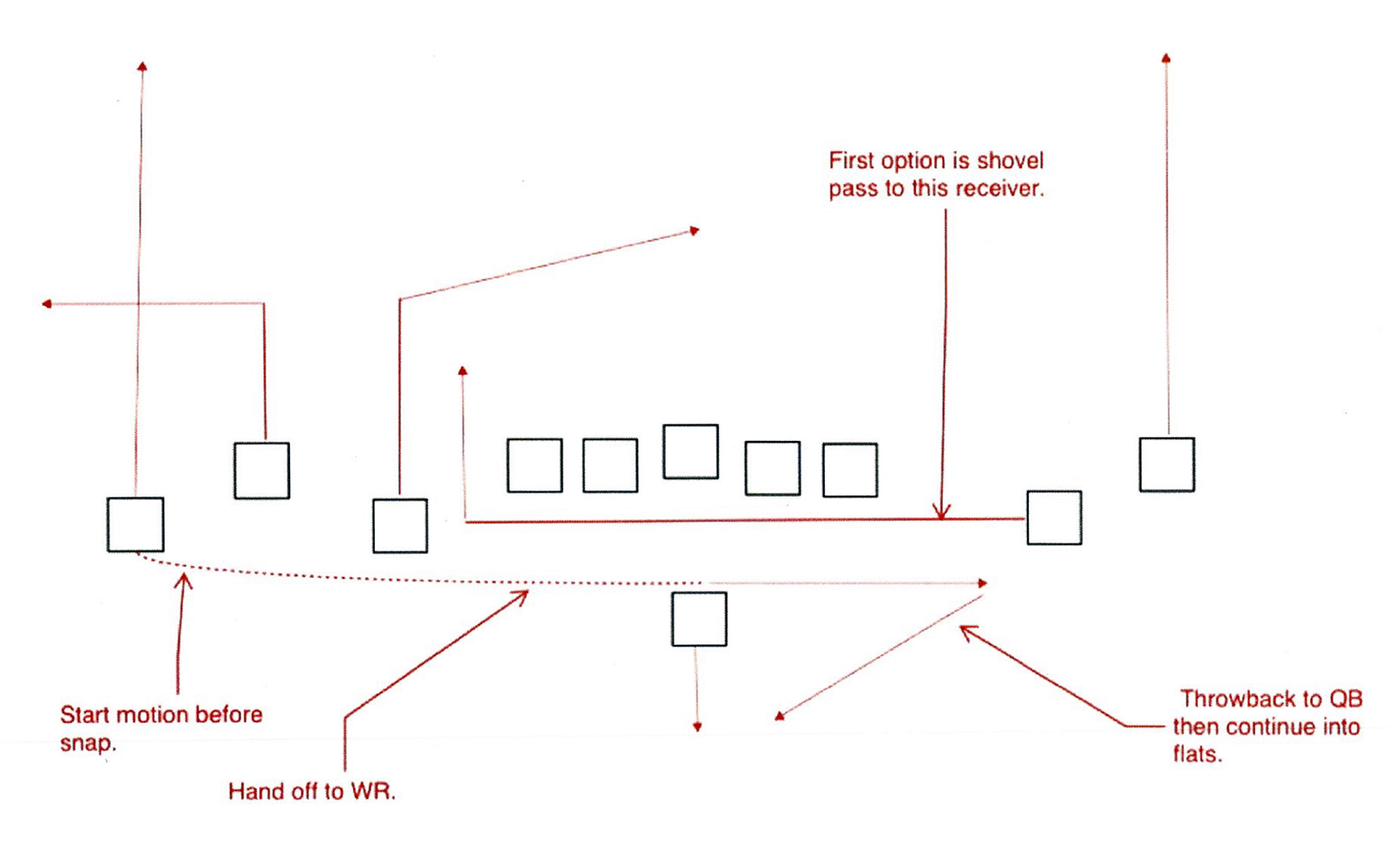
Description: This play uses a five-receiver set with an empty backfield. The receiver to the far left starts the action by coming in motion pre-snap. Once the ball is snapped, the quarterback hands the ball to the receiver in motion, who then continues a few steps toward the sideline and then tosses the ball back to the quarterback, in an inverted flea flicker. There’s also an option to shovel the ball to a slot receiver behind the offensive line.
Leach’s take: “I like this play,” Leach says. “It’s a flea-flicker from a horizontal angle.” He thinks this play would be especially effective if you ran a fly sweep, too. “It looks like a fly sweep coming,” Leach says. “Then the fly sweep guy flips it back to the quarterback.”
Leach’s concern is that the play will take long to develop, and therefore, you need to be mindful of where you have the receivers running routes. “Those routes could out-run the arm of the quarterback if you’re not careful,” Leach says, “because there’s extra time to [developing the flea flicker].” For instance, he would probably change the second receiver’s route. Instead of running an “out” route, he’d have that receiver run a post, over the top of the third receiver in the slot, who’s running a crossing route underneath. “I like how they’re layering it up,” Leach says. “I like the guy crossing there, because people are going to be incline to bite up [due to the fake fly sweep], so there could be space. That could be an easy throw.”
4. Play Design 3
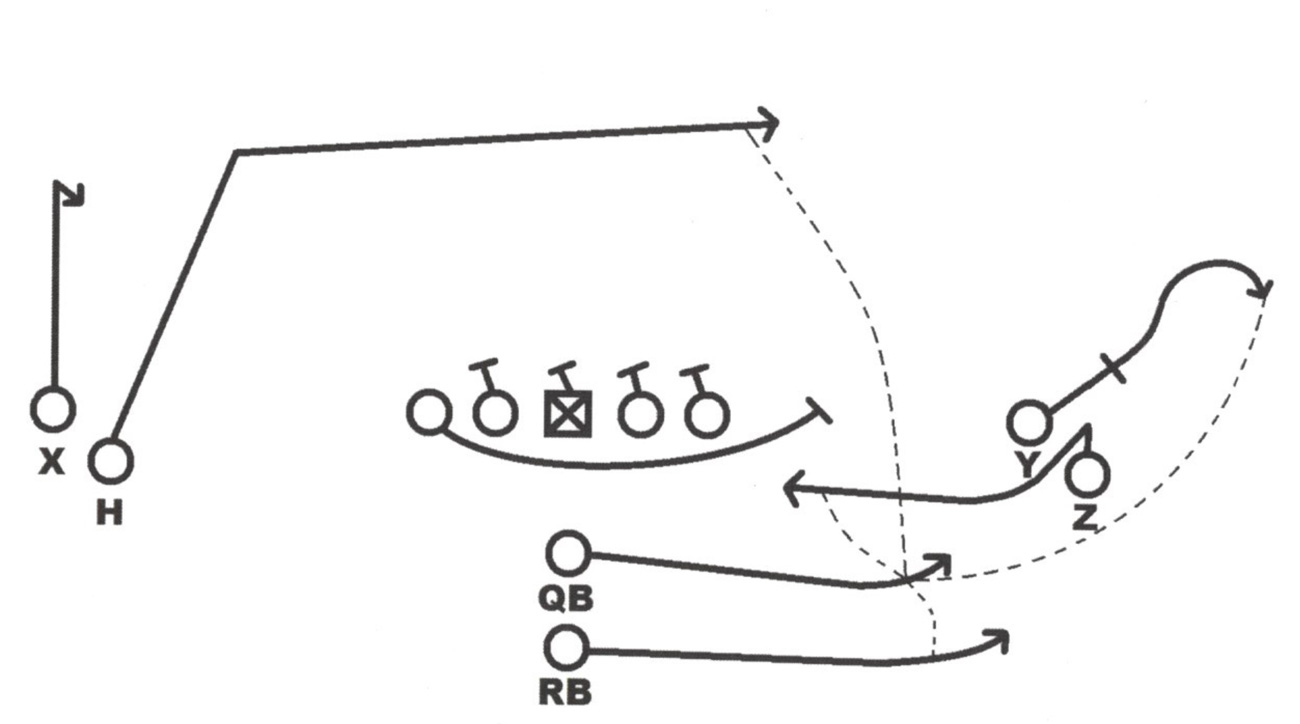
Description: This is an option play specifically designed for the red zone. The quarterback takes the snap and starts running to his right and has five options of what to do with the ball. He can shovel the ball to the Z receiver, who is diving inside; he can toss the ball to the Y receiver, who is running a “rub route” off of the Z receiver, toward the outside; he can throw the ball to the H receiver, who’s running a crossing route downfield; he can pitch the ball to the running back, who’s running behind him; or he can keep the ball himself.
Leach’s take: Leach seemed impressed by this play’s detail. He liked how the various options meshed with one another, particularly the “rub route” action with the Z and Y receivers. “I think what they’re doing with Z and Y is really pretty clever,” Leach says. “If they follow Z, you throw it to Y. If they don’t follow Z, you throw it to Z. That’s very simple.”
The only thing is, Leach thinks five options may be too many for the quarterback to read, essentially, in a split second: “I don’t think the quarterback, as he takes the snap, can sprint out there and say, ‘Should I run? Should I pitch? Oh damn, I missed the Z. Should I shuttle pass it to Z? Or should I throw it to Y? Is Y going to sit there or is Y going to run his route?’ I think that’s too difficult.” Instead, if Leach were to call this play, he’d tell his quarterback to focus on only two of the five options, and he’d choose those two based on how the defense was playing them. “You could potentially run the play three times, and have two different options each time,” he says. “You could have two sets of options one game, two sets of options the next game, and then two sets of options the following game, and then start all over again.”
5. Yankee Cross
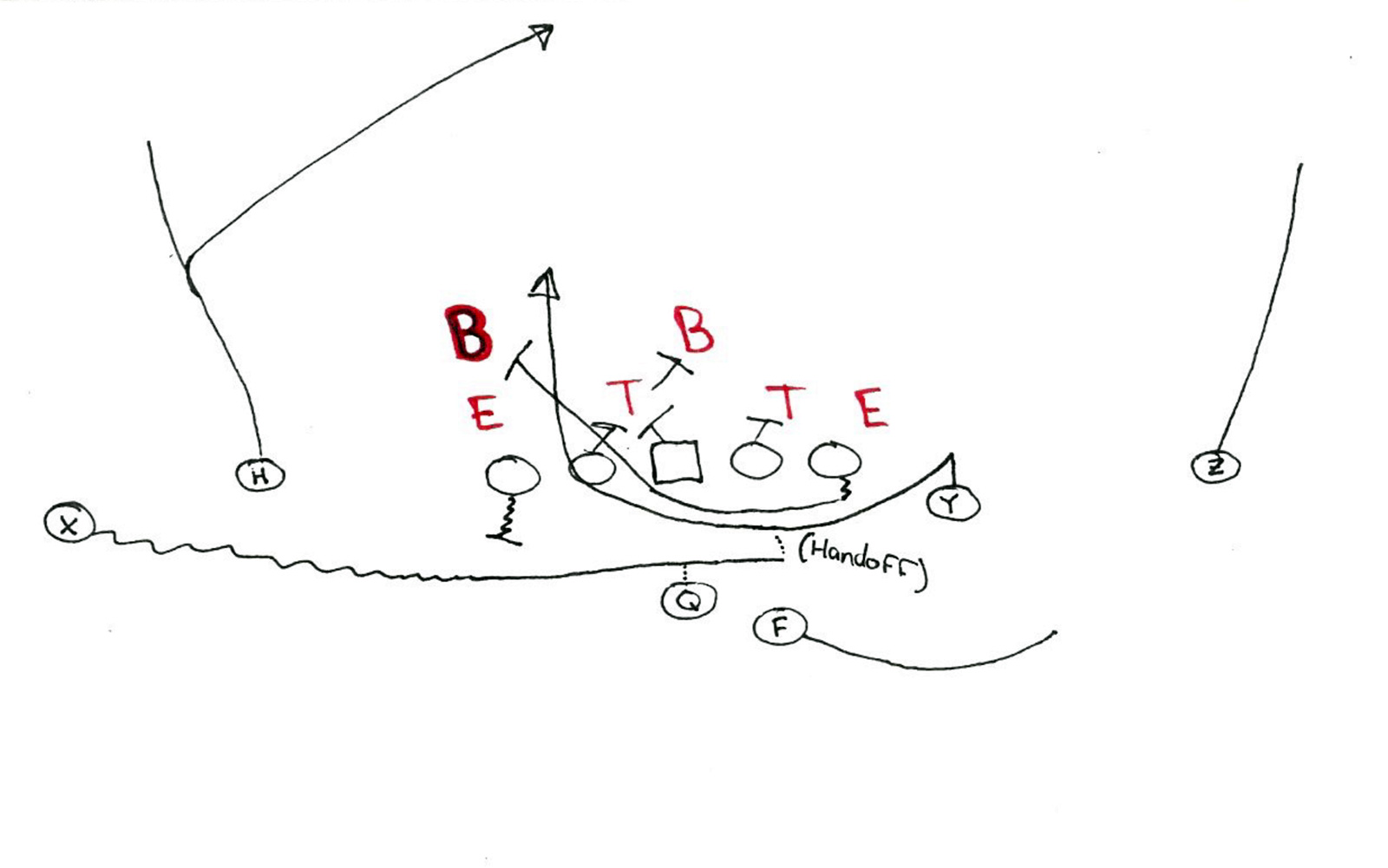
Description: This play starts with the X receiver motioning across and taking a touch pass from the quarterback. The X receiver only has the ball momentarily, though. He quickly hands the ball to the Y receiver, who started in the slot to the right, and is now sprinting to the left, behind the line. The play appears to be part reverse, part counter, because once the Y receiver gets the handoff, he’s supposed to hit the hole between the left guard and the left tackle. The right tackle is also supposed to pull around to that side to clear a path.
Leach’s take: Leach seems intrigued by this play, especially if he has the speed at the X and Y receiver positions to run it properly. He also likes the misdirection involved here, and the way the student designed the blocking scheme. “I think you can block it up pretty good,” Leach says. “The line play on it is kind of appealing. I like that play from the beginning.”
His one concern is that the handoff between the receivers could get messy. “There’s a fear with the handoff, because it happens really kind of too quick,” he says. Instead, Leach would have the X receiver motion across, have his quarterback fake the handoff, and then have the quarterback toss the ball to the Y receiver, who can hit the gap the same as before. The X receiver would act entirely as a decoy, coming across the formation on a fake fly sweep. “It would probably work,” Leach says. “You can’t run it every time, but if you’re determined to run the fly sweep, I think it’s a good complement. I think it keeps them honest.”
Leach says that all five of these plays were well thought-out, which may be the highest compliment he can give. “There was really no right or wrong answer [to the class assignment],” he says. “There’s a well thought-out play, and then there’s one where you’re just tearing a page out of your junior high playbook, without any real thought to it.”
Now, will Leach run one of these plays against Houston? Or maybe another student-designed play from his class? He isn’t sure as of yet. “I just don’t want to promise anything,” Leach says. “We might—but different games dictate different things, you know?”
